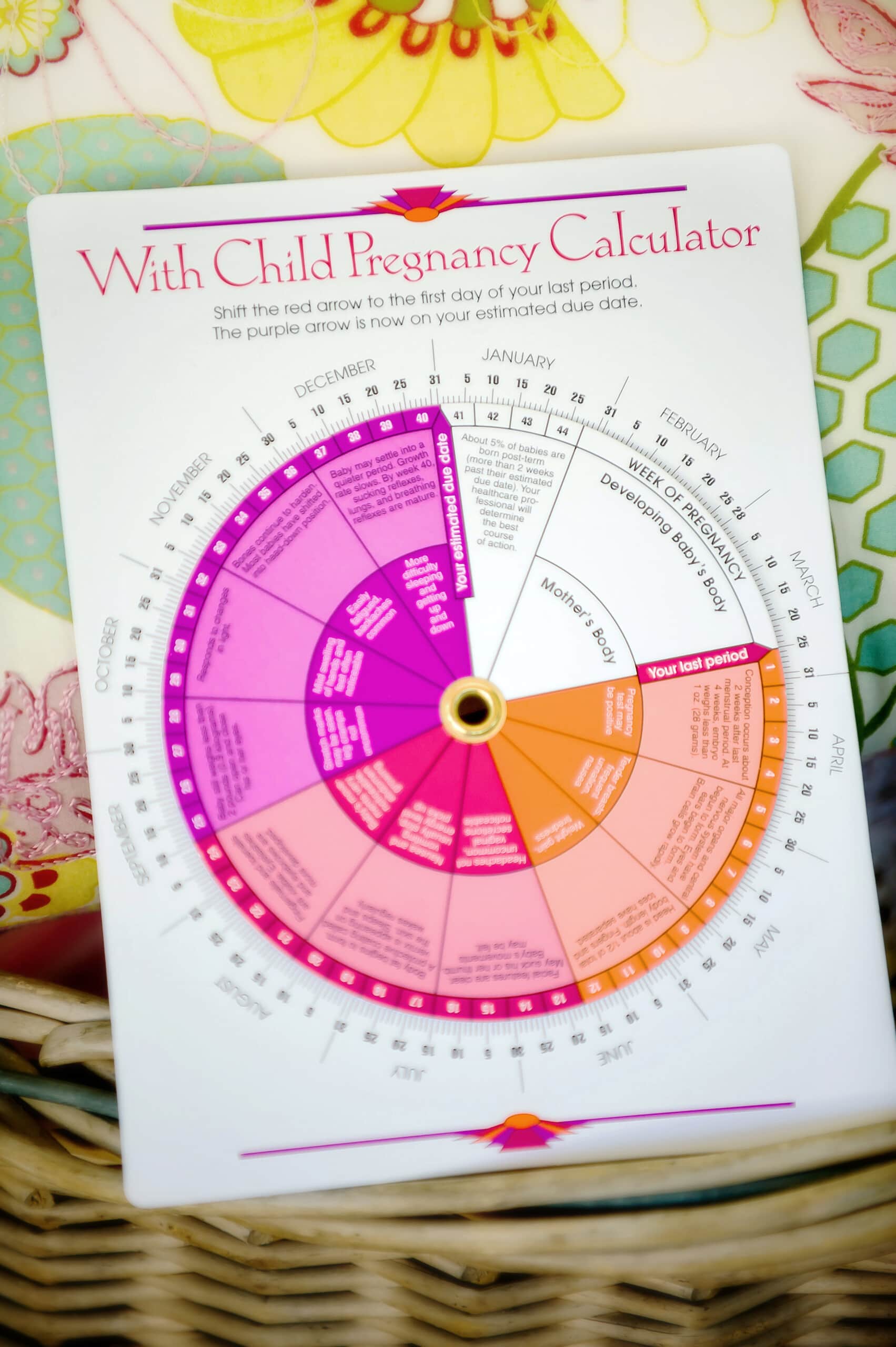
When you find out you are pregnant, you circle your due date on your calendar and commit it to memory. When you have been counting down the days until your due date for nine months only to go past it, frustration and anxiety may set in when you have an overdue baby.
You may feel pressure from your provider to have an induction for your overdue baby. Even if your provider is not pressuring you, you might just be ready to get your late-arriving baby out. But it’s essential to understand what “overdue” means, the risk of being overdue, and your options when you have an overdue baby.
How Does Your Doctor Calculate Your Due Date?
A baby is classified as overdue based on their due date. A “due date” refers to when a pregnancy reaches 40 weeks gestation, but there are many ways to determine that 40-week mark.1
Ovulation Date or Last Menstrual Period

The most accurate due date would be calculated by adding 38 weeks to a woman’s ovulation date. However, many women do not know exactly when they ovulate. Therefore, most practitioners assume women ovulate two weeks after the start of their last menstrual period and add 40 weeks to that to calculate the estimated due date. This is why pregnancy is said to be 40 weeks long.2
If a woman has short or long menstrual cycles or ovulates later in her cycle than the presumed day 14, this standard calculation can make the due date inaccurate.2 You can use our due date calculator to help you better determine your due date according to your cycle length and more specific details.
Ultrasound

Due dates are estimates based on a dating scan or an ultrasound early in the first trimester. Because cell division in early pregnancy follows a very predictable timeline, the size of an embryo in the first trimester is rather accurate at predicting gestational age and due date.3
If a woman does not know the date of her last menstrual period and does not have an early pregnancy scan, her due date can also be estimated by an ultrasound later in pregnancy to look at the baby’s size. However, as pregnancy progresses, fetal size becomes more variable and ultrasound-estimated due dates become less accurate.3
Measurement

The fundal height is the measurement from your pubic bone to the top of the uterus (the fundus) during pregnancy. Fundal height can be used to estimate how far along a pregnancy is and the due date. At 20 weeks gestation, the uterine fundus should be at your belly button. After 20 weeks, the fundal height in centimeters should roughly correspond to the number of weeks in pregnancy.4
When is a Baby Overdue?
A baby is overdue based on how far beyond their due date they have gone. Overdue babies can be classified as “late-term” or “post-term.” 5
Late-term babies refer to pregnancies lasting between 41 weeks, 0 days, and 41 weeks, six days, or between one and two weeks after their due date. Post-term babies have gone past 42 weeks of pregnancy or more than two weeks after their due date.5,6
How Common is an Overdue Baby?
It is estimated that between 5% and 7% of all pregnancies go beyond 42 weeks of gestation.7
What Causes a Post-term Pregnancy and Overdue Baby?
There are several reasons a post-term pregnancy might occur.
Incorrect Due Date
The most common cause of an overdue baby is an incorrect estimate of their gestational age. For instance, women with long menstrual cycles or big babies might have overestimated their gestational ages. Thus, their due dates may be mistakenly early, causing a false assumption of an overdue baby.7
Hormone Deficiency
Although it is not known precisely what triggers the start of labor, hormones certainly play a role. A deficiency in hormones such as a placental hormone and estrogen can prevent labor from starting on its own, thereby making a pregnancy continue and a baby overdue.7
Obesity
Women with obesity are more likely to have a post-term pregnancy. While scientists do not understand exactly why, it is thought that perhaps increased body fat alters hormone activity and metabolism, which could inhibit the start of labor.7
First Baby
Mothers who have never given birth before are more likely to have an overdue baby, though no one is exactly sure why. Perhaps your body’s experience with going through labor before helps to get things started the next time.7
Genetics
Women whose mothers had overdue babies and mothers who are twins and their twins have had overdue babies are likelier to have overdue babies themselves. This points to a potential genetic component for the cause of overdue babies.7
Previous Post-term Pregnancy
Women who have already had one, or especially if they have had more than one overdue baby, are more likely to have another.7
Male Fetus
Boy babies are more likely to be overdue than girl babies.5
What to Expect With an Overdue Baby
If your pregnancy goes beyond 40 or 41 weeks, your provider might increase their surveillance of your and your baby’s health to ensure a safe delivery for both of you. Here are some types of monitoring your provider might do as you progress toward having an overdue baby.
Nonstress Test
A nonstress test monitors your baby’s heart rate as they move. You indicate when you feel a kick, and the test will look for the baby’s heart rate to accelerate during those movements. Our heart rates increase with exercise, and your baby’s heart rate should too. If it does not, you may need additional testing.8
Biophysical Profile
A biophysical profile (BPP) combines a nonstress test with an ultrasound. The ultrasound looks for your baby’s breathing and body movements, muscle tone, and amount of amniotic fluid. A biophysical profile is scored out of 10 points, with two points given for each component. A low score can necessitate further testing or immediate delivery.9
Contraction Stress Testing
Your provider may perform a contraction stress test if you have atypical results during a nonstress test or biophysical profile and induction is being considered. During contraction stress testing, your provider administers a small dose of Pitocin to induce contractions, then monitors contractions and fetal heart rate. If fetal heart rate indicates your baby does not tolerate contractions, this can mean your baby may not tolerate labor and may need a C-section. Continued monitoring or further testing may be indicated.10
Size
Ultrasound estimates of fetal size can be very off in late pregnancy. Your provider may order a growth scan to help determine whether your baby’s size may affect having a successful vaginal delivery. Or they may order one if there is a concern for intrauterine growth restriction.11
Risks to the Baby if They’re Overdue
Increased risks emerge for the baby if your pregnancy exceeds 41-42 weeks.
Large Baby
Because a baby continues to grow within the uterus even after the due date has passed, they are more likely to be a large baby at birth. This can cause the baby to not fit through the birth canal or their shoulders to get stuck, called shoulder dystocia. Shoulder dystocia can lead to other complications, such as broken bones and nerve damage.7
Dysmaturity Syndrome
If the placenta starts to give out due to aging, your baby may suffer consequences such as a thin body and low amniotic fluid volume. Low amniotic fluid volume can cause umbilical cord compression, which may decrease blood flow to the baby.7
Meconium Aspiration
Meconium refers to your baby’s first bowel movements. Babies passing a bowel movement before delivery may breathe it in and choke on it. The likelihood of this happening increases beyond your pregnancy’s due date.7
Stillbirth and Infant Death
The risk of stillbirth dramatically accelerates after 40 weeks of pregnancy. These deaths are most often caused by placental insufficiency, meconium aspiration, or infections like chorioamnionitis.7
Risks to Mom With an Overdue Baby
Because overdue babies are more likely to be large and get stuck, moms of overdue babies are likelier to have abnormally slow labor, severe vaginal tearing, and an operative vaginal delivery requiring forceps or a vacuum.5,7,12
The cesarean section rate doubles at 42 weeks compared to 40 weeks. After 39 weeks, pregnancy complications such as chorioamnionitis and hemorrhage increase.7
There is also an emotional toll that overdue pregnancies can take on pregnant mothers. Passing your due date can lead to frustration or desperation to meet your baby, and while no woman can stay pregnant forever, this component should not be overlooked.
How To Prevent or Manage an Overdue Baby
You can take steps to avoid having an overdue baby or encourage your baby to enter the world in a timelier fashion.
Maintain a Healthy Weight
Women who brought their body weight out of the obesity range were slightly less likely to go past 41 weeks of pregnancy.7
Eat Dates
Studies have shown that eating dates in the final weeks of pregnancy can reduce the need for labor induction and augmentation.13
Have Sex
While it may be challenging to get in the mood at 40 weeks pregnant, there is a theory that the female orgasm and a chemical component in male semen might help start labor. Research studies have not confirmed this, but it is unlikely to cause harm to you or your baby.14
Drink Red Raspberry Leaf Tea
One study demonstrated that red raspberry leaf tea might slightly decrease the likelihood of having an overdue baby. It may also shorten labor and decrease the risk of labor induction and augmentation interventions.15
Acupressure and Acupuncture
Acupressure and acupuncture have long been thought to help get labor started or progress along, though data conflicts on their effectiveness.16
Membrane Sweep
During a membrane sweep, your provider uses a gloved finger to separate the cervix from the amniotic sac. Doing so releases natural hormones that can be effective at starting labor within 48 hours.5,17
Induction
If your baby is significantly overdue with no signs of budging, or testing shows that the baby may be in danger if they stay in much longer, your provider may recommend proceeding with labor induction. Depending on the status of your cervix, induction might begin with a tool or medication inserted vaginally, or you may start on Pitocin to ramp up contractions.5
If you are pregnant, overdue or not, it is a good idea to have a conversation with your provider about how far past your due date they recommend staying pregnant before intervening. You can do every natural technique to “evict” your baby, and they may still decide they are more comfortable in your womb than on the outside.
If you are hoping for a low-intervention birth, you must weigh the risks and benefits of remaining pregnant and allowing labor to start naturally if you have an overdue baby. After all, you might be pregnant longer than you would like, but no woman can stay pregnant forever.
from Baby Chick https://ift.tt/j47DcFf
via IFTTT



0 Comments
Please ,
Don't enter span link ...